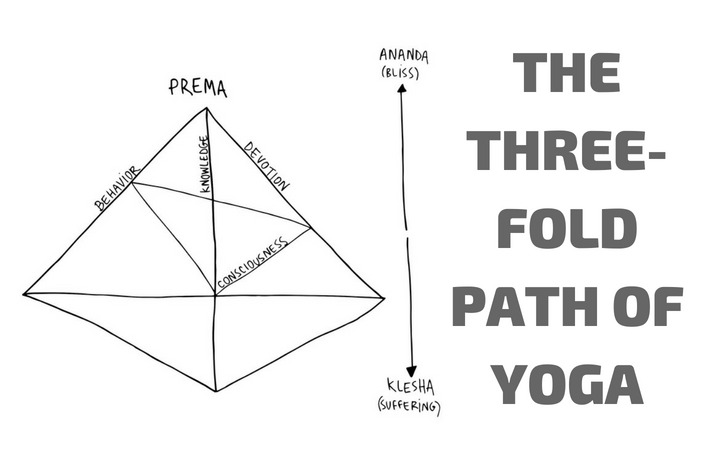One way to look at the path of yoga is to divide it into three separate aspects, or avenues of progress. Let’s take a look at that here and how we can apply this to our lives.
Author: Giridhari Das
In Patanjali’s Yoga Sutras we find an interesting definition of 3 things we need to be successful in yoga. Let’s take a look at that here.
Among other things, Patanjali’s Yoga Sutras are famous for the yamas and niyamas, which are the very basis of the entire path of yoga. Here we’ll briefly explain the 5 niyamas.

3T Path Retreat in the Bahamas Coming Up!
I’m excited about my upcoming retreat in the Bahamas, from the 15-18th of July!
Among other things, Patanjali’s Yoga Sutras are famous for the yamas and nimayas, which are the very basis of the entire path of yoga. Here we’ll briefly explain the 5 yamas.

Why Are We Here?
Why are we here? Yoga is adamant in stating that ignorance leads to all other suffering. But not so much is said about how it all began. Why did I become ignorant? When? How? Find out more here.
Be aware that you are not seeing life as it is. You’re seeing it as you are, according to unconscious filters you have created, which control what information reaches you. How does this happen? How is it affecting your life? And how can you change this? Find out more here.
Life isn’t easy. Every day we have to deal with so-called problems. Let’s see here how the 3T Path gives you all the tools and knowledge you need to diminish and even overcome life’s problems.

5 Steps To An Amazing Life
Here are five steps to an amazing life. At every step, your life will get noticeably better. Put together, you’ll be experiencing perfection. This is not something made up, but the cumulative wisdom of thousands of years of the yoga tradition, now confirmed by modern science.
Step#1: Self-observation
The first step is to look inside. Before you can make any changes to how you’re living and what your mind is doing, you have to become a witness to your own self. What are you thinking, what’s your focus, what are you feeling? Track your mind’s movements and get in touch with not only your emotions but what’s behind them. Keep track of your motivations and desires and see what their outcomes are.
Take time to examine your consciousness. Silence is key for this. Focus not on external things or your endless to-do list, but just on yourself. Get to know yourself deeply.
Step#2: Self-responsibility
Once you’re looking inside, now you can start taking control of what’s going on. This is when you take the helm and direct your life to where you want it. You assume FULL responsibility for your well-being. No more victimhood. You put aside any idea that your happiness depends on anything or anyone else. You and you alone call the shots when it comes to how you’re feeling and the quality of your life.
You can read more about this in my earlier blog on the topic.
Step#3: Mindfulness
Now that you’re trying to command your mind, the first thing you need to do is to bring it to the here and now, which is a basic definition of mindfulness. Mindfulness is the portal for all higher states of consciousness. Being in the here and now is the solution to just about every form of suffering you impose on yourself.
As your mind drifts to the past, you experience melancholy and lamentation. When your mind jumps to the future, in the false hopes of future happiness, you experience anxiety, fear, and frustration. True joy begins in the now.
You can read more about this in my earlier blog on the topic.
Step#4: Dharma
Being in the here and now allows you to bring your full attention to your task at hand. This raises a key question: what should I do? This is where the concept of dharma comes in.
Dharma means your duty and essence. What’s the best you can do right now? What’s the purest expression of the best of you at this very moment?
Dharma means prioritizing your true nature and learning to balance out your different demands and responsibilities properly. It’s about being guided by values, not external goals. It’s about living your purpose.
This is one of the key components of The 3T Path. This video will help you understand the concept a little better.

Step#5: Bhakti
Lastly, and most importantly, you need transcendence. You need love. Bhakti means transcendental love and devotion. Once you’re in the here and now, living the best of you, now you can make that your spiritual practice, by connecting it all in love of God. Love is the highest expression of the soul. You know this because you’ve experienced how love makes feel great.
But love requires an object. You have to love someone. And you can only love someone to the extent they are “loveable”. That’s why, though we can all agree that love is the highest state of mind, we end up not experiencing it enough. Not many people are so loveable.
Even if you don’t understand or accept the concept of God, at least you can see the logic here. God is defined as infinitely loveable. As such, you can love Him and Her infinitely, which naturally gives you access to an infinitely high state of consciousness and bliss. As an added bonus, God, being transcendent, is always with you, so you can experience this loving connection anywhere, at any time.
Conclusion
So, there you have it: 5 steps to an amazing life. The first four will make your life flow with grace and enthusiasm. The last will take you beyond the constraints of material life, to an ocean of bliss.
In the book, The 3T Path (https://3tpath.com/books/) you can see in detail all these points, the techniques necessary to make them happen and how this can transform your life.
Watch my video on this topic here.

Look what they’re saying about The 3T Path book: “A life-saver!” – Ivan Llobet

How To Deal With Loss
Loss brings about great suffering. But what is the basis of this suffering? What’s behind this? Is there a way to disarm this source of pain or to minimize it? Here we’ll see how to deal with loss.
First, a meditation: “if you’ve lost something, it’s because it wasn’t really yours”.
What you lost was not the person or object. That was never “yours”. You’re not the ultimate owner of anyone or anything. You lost the illusion that it was yours.
And that’s what’s making you hurt. The brutal reencounter with the reality that nothing is yours deeply disturbs those who base their lives on the illusion that happiness comes claiming ownership of things and people.
Not even your body is yours. Did you make your body? I didn’t make mine. A rock, a fiber of cotton, water, earth… none of this is yours. You can’t make any of this. For those who have activated their devotion, the concept is easy enough to understand: everything belongs to God.
This concept is central to yoga and essential for living in peace: nothing belongs to you. You are just you. Consciousness. The soul.
That’s why things enter and leave your life beyond your control. Because they are not yours. When we don’t understand this, inevitably we experience the harsh lesson of loss.
And what about losing loved ones? It’s beyond awful. So much pain. But that person was never “yours”. The person was never really “your” brother or “your mother”. You never owned that person. The person was an eternal soul who came and played that part in your life, and now he or she is gone. Every relationship here has a beginning and an end. I was born, I will die. You were born, you will die. The pain of separation can be mitigated with a dose of reality: every person has always existed and will always exist. Only your time with that person, under those conditions, has ended. You can learn more about this topic of life after death in this video.

You’re a tourist. Only passing through. You arrived with nothing and no one and you’ll leave with nothing and no one. Everything you have is on loan, to be used while you’re here. The only thing that’s absolutely certain in life is that you won’t leave with anything or anyone.
The feeling of loss is a call for your awakening. We have to wake up to our internal reality. Even if you don’t believe in soul or God, you still cannot deny that you’re conscious and your experience of life in internal and metaphysical.
That’s why any step you take in this direction will bring you enormous positive gain and wellbeing. Changing extrinsic objectives for intrinsic objectives, prioritizing peace, emotional health, love… all of this will bring about huge gains and save you from the suffering that naturally arises from focusing on external things like money, things, social status, etc.
In the book, The 3T Path (https://3tpath.com/books/) you can see in detail how to develop the mental power and vision to conquer this paradigm shift and, thus, how to deal with loss.
Watch my video on this topic here.

Look what they’re saying about The 3T Path book: “a richly rewarding experience” – Chaitanya Charan Das






